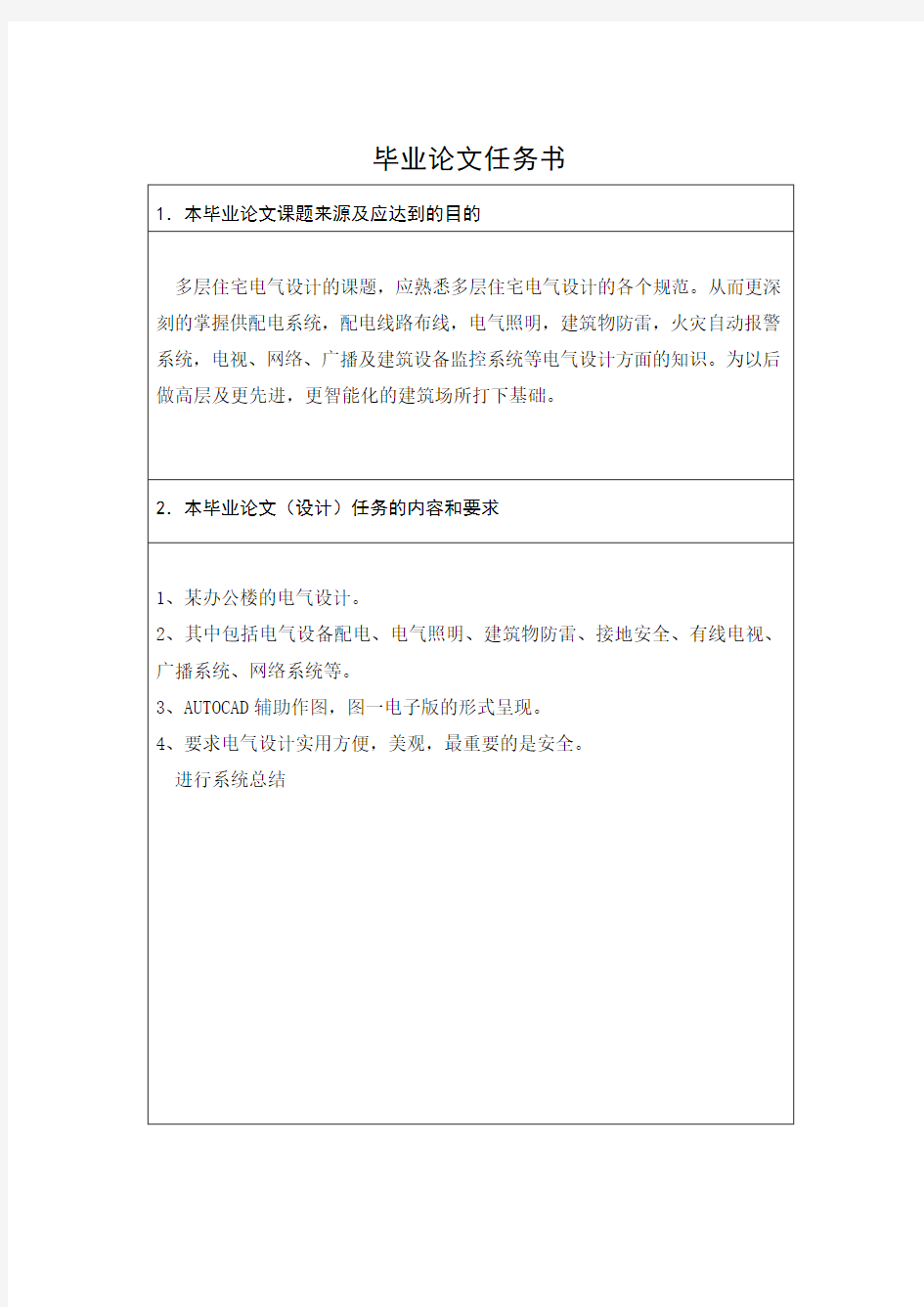
建筑电气专业毕业设计论文
- 格式:doc
- 大小:209.00 KB
- 文档页数:36


毕业论文任务书
摘要
主要对其进行供配电系统、照明系统、防雷接地,综合布线系统等弱电设计,总建筑面积7558.94平方米,为学校标志性建筑。按照建筑设计要求,所有教室均按多媒体教室设计。
该工程首先对供配电系统进行设计,在供电系统中涉及到建筑供配电的负荷分级和智能建筑对供电的要求以及如何减少电能损耗。在低压配电系统设计中主要考虑配电系统的原则,配电系统配电方式以及配电设计的质量。最后利用需用系数法对系统的负荷进行计算。
照明系统的设计是在照度要素和要求的基础上,满足照度均匀度,亮度均匀度,眩光的限制与利用,颜色对比,阴影的处理,照度的稳定性等的要求,利用单位容量法对光源和灯具进行选择和布置。然后根据各回路的计算电流来选择使用的开关,插座,导线,断路器等器件。
弱电部分的设计主要是消防和综合布线系统的设计,综合布线是采取标准化的统一材料、统一设计、统一布线、统一安装施工做到结构清晰,使用方便,便于集中管理和维护。
关键词:供配电系统 , 照明系统, 弱电系统 , 建筑物防雷系统,弱电系统
外文翻译
Electrical design of integrated building
Its main power supply and distribution systems, lighting systems, and other strong electrical socket system design , such as weak cabling systems designed to meet all the requirements of a modern intelligent building .
The project first power supply and distribution system design, supply and distribution of construction related to the classification and intelligent building load power requirements of the power supply system and how to reduce energy loss . Principles in the design of low-voltage distribution system mainly consider the distribution system , distribution methods and the quality of the distribution system distribution design. Finally, the required system load factor method of calculation .
The design of the lighting system is based on the requirements of the illumination elements and meet the illumination uniformity , brightness uniformity, requires the use of restrictions and glare , color contrast , processing, stability of the shadow of illumination , the method of using the light source unit capacity and the selection and arrangement of luminaires . Then the calculated current of each loop to select switches, sockets, wires , circuit breakers and other devices to use.
Weak part of the design is mainly designed Fire and cabling systems , cabling is to take a standardized uniform material , unified design , unified routing , unified installation and construction to achieve a clear , easy to use , easy to centrally manage and maintain
目录
前言 (1)
第一章绪论 (1)
1.1 建筑电气概况 (1)
1.2 设计原则 (1)
1.3 设计内容 (1)
第二章配电系统设计 (3)
2.1 负荷等级及供电求 (3)
2.2 负荷计算 (4)
2.3 导线选择 (5)
2.4 配电方式 (5)
第三章照明系统设计 (6)
3.1 总则 (6)
3.2 照明光源选择 (6)
3.3 照明灯具选择 (6)
3.4 照度和照明方式的选择 (6)
3.5 一般照明 (7)
3.6 应急照明 (7)
3.7 照度计算 (8)
第四章照明系统设计
4.1开关的设计及要求 (10)
4.2 插座的设计及要求 (10)
第五章防雷接地系统设计 (12)
5.1 建筑物的防雷措施 (12)
5.2 本建筑物防雷接地系统设计结果 (12)
第六章弱电系统设计 (13)
6.1 有线电视系统设计 (13)
6.2 电话网络系统 (13)
结论 (14)
参考文献 (15)
外文翻译 (16)
谢辞 (17)
附录:图纸
前言
随着社会经济的发展,科技的进步,现代办公建筑的用电设备种类越来越多,如电力、照明、电梯、空调、消防、通信、计算机等,而且不断向智能化设备方面发展,所以对其的电气设计可以说是非常关键的环节,它直接决定了综公楼的使用效率,和办公能力。
本论文主要阐述了教学楼各系统电气设计的设计依据、原理和方法及设计选择的结论。本论文共包括五章的内容,前四张包括强电部